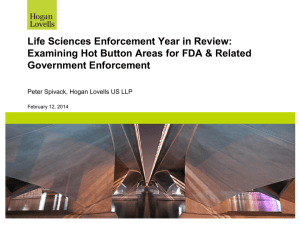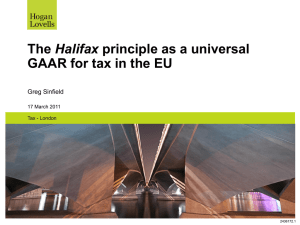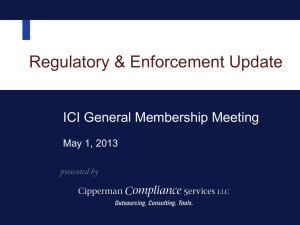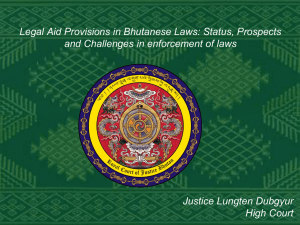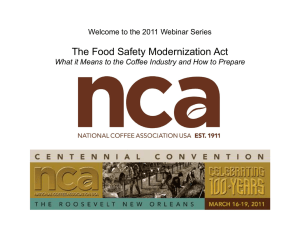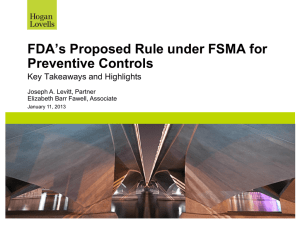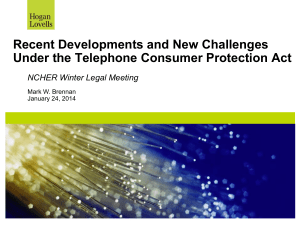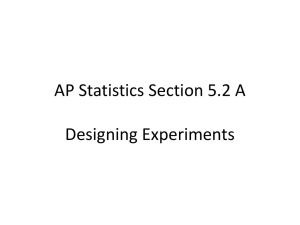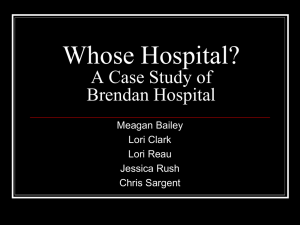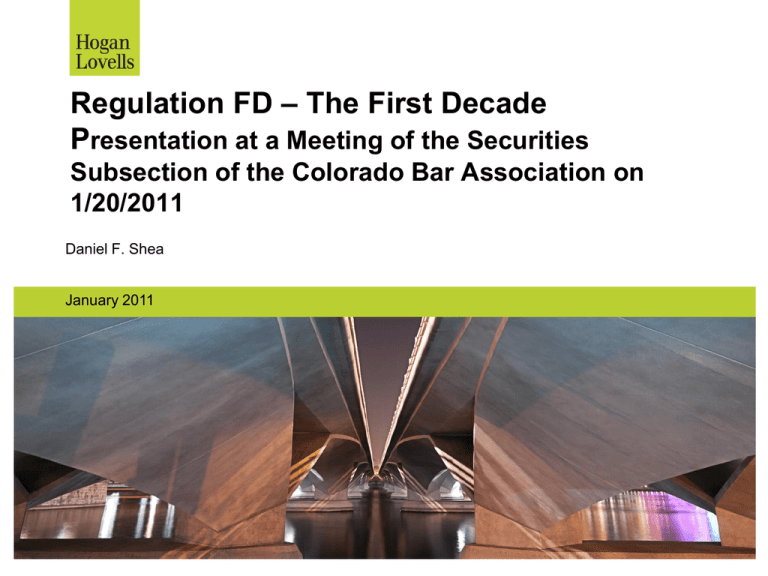
Regulation FD – The First Decade
Presentation at a Meeting of the Securities
Subsection of the Colorado Bar Association on
1/20/2011
Daniel F. Shea
January 2011
History, Purpose and Effect of Regulation FD
• Regulation Fair Disclosure, commonly referred to as
Regulation FD, was adopted by the SEC in August 2000.
• Purpose is to prohibit selective disclosure of material nonpublic information to investment professionals and
institutional shareholders of public companies.
• Only authorized enforcement actions by the SEC; no private
rights of action were created.
www.hoganlovells.com
2
Regulation FD
To what communications does Regulation FD
apply?
• Regulation FD applies to the disclosure of material nonpublic information by public companies and persons acting
on their behalf to:
•
•
•
•
•
•
www.hoganlovells.com
Broker-dealers (in particular their research analysts)
Investment advisers and managers
Investment companies
Hedge funds
Pension funds
Any other investor under circumstances in which it is reasonably
foreseeable that such person would buy or sell the securities on
the basis of such information
3
Regulation FD
To what communications does Regulation
FD not apply?
Selective disclosure of material non-public
information may be made to:
•
•
•
•
•
Persons who owe a duty of trust and confidence to the company
(e.g., an attorney, investment banker, or accountant engaged by the
company)
Other persons who agree to keep the information confidential
Persons who receive the information in connection with a registered
public offering (e.g., during a roadshow presentation) except for
certain continuous offerings (e.g., resales, dividend reinvestment
plans, employee benefit plans, direct stock purchasing plans, and
exercises and conversions)
Media outlets
Existing and potential customers and vendors
www.hoganlovells.com
4
Regulation FD
To whom does Regulation FD apply?
Persons deemed to be “acting on the company’s behalf”
include:
•
•
•
Any senior official defined to include any Section 16 officer, director,
Investment Relations (IR) director, Public Relations (PR) director, and
any other person having such a role
Any other officer, employee, or agent of the company who
communicates with market professionals or stockholders (e.g.,
employees in the investor relations or public relations departments)
Investor and/or public relations firms used by the company
www.hoganlovells.com
5
Regulation FD
Does Regulation FD apply only to affirmative
communications?
Regulation FD applies with equal force to affirmative
statements and reactive remarks:
•
•
•
Affirmative statements are much more likely to be deemed intentional
Reactive remarks, while less likely to be deemed intentional, are
nonetheless covered by Regulation FD
Company officers and employees therefore should avoid reacting
extemporaneously to rumors. Rumors related to information that is
material should not be quashed selectively; rather, the company
should adopt and follow a policy for determining which rumors should
be quashed and do so by publicly disseminating the company’s
refuttal of the rumor
www.hoganlovells.com
6
Regulation FD
Examples of types of disclosures likely to deemed
public:
• Widely disseminated press releases
• Investor conference calls preceded by adequate notice
• In limited circumstances, postings on a company’s
website (see SEC’s August 2008 guidance regarding Use
of Company Websites)
www.hoganlovells.com
7
Regulation FD
Intentional Disclosures
•
Disclosures will be deemed “intentional” only when person making the
disclosure knows, or should know, that the information is material and
non-public
•
Intentional disclosures must be made “simultaneously” to all
shareholders so company should take prompt action to make broad
public disclosure once it learns of any selective disclosure of material
non-public information to market professionals
•
Recognizing that materiality is sometimes an elusive concept, then
Enforcement Director Walker stated in November 2000 that SEC was
“not going to second-guess close calls regarding the materiality of a
potential disclosure.” Thus, according to Walker, for the SEC to
allege that a selective disclosure was intentionally made, the act must
be an “extreme departure from standards of reasonable care”
www.hoganlovells.com
8
Regulation FD
Non-Intentional Disclosures
•
Non-intentional disclosures are those made inadvertently (for
example, where the company spokesperson believes that the
information is immaterial or has already been disclosed publicly or
where the statement is made extemporaneously, such as in response
to a question posed by an analyst)
•
Non-intentional disclosures must be cured “promptly” meaning “as
soon as reasonably practicable” but no later than 24 hours after the
statement was made or before the start of trading on the next
business day
www.hoganlovells.com
9
Regulation FD
Publication of Corrective Disclosures
•
•
The methods of public disclosure can vary, so long as they are “reasonably
designed to effect a broad and non-exclusionary distribution of information to
the public”
Best practice is to issue press release that is incorporated in a Form 8-K filing
www.hoganlovells.com
10
Regulation FD
Non-public:
•
Information that has not been widely disseminated to the public
Material:
•
There is a substantial likelihood the information would be important to a
reasonable investor in making an investment decision
www.hoganlovells.com
11
Regulation FD
What is material information?
•
•
Short answer = nearly all non-public information, particularly given
that any disclosure will likely be judged with the benefit of hindsight
Long answer = too many items to commit to memory
www.hoganlovells.com
12
Regulation FD
Regulation FD lists certain information as
presumptively material:
•
•
•
•
•
•
•
•
•
Earnings information
Mergers, joint ventures, acquisitions, tender offers, or significant
changes in assets
New products or discoveries in R&D area
Developments regarding customers or suppliers, particularly new or
terminated agreements
Changes in control or management
Change in auditors
Notification from auditor that prior audit report can no longer be
relied upon
Events regarding the company’s securities (ex: stock splits, stock
dividends, sales of additional securities, or defaults on senior securities)
Bankruptcies or receiverships
www.hoganlovells.com
13
Regulation FD
Form 8-K instructions list other information
as presumptively material:
•
•
•
•
•
•
•
•
•
•
Costs associated will exit or disposal activities
Material impairments
Notice of delisting from exchange
Unregistered sale of securities
Material modifications to rights of securities holders
Amendments to Articles of Incorporation or Bylaws
Change in fiscal year
Acquisition or disposition of significant assets
Events that trigger an acceleration or increase in direct financial
obligation or obligation under off-balance sheet arrangement
Material agreement or change in agreement regarding
compensation of certain highly compensated officers
www.hoganlovells.com
14
Regulation FD
Examples of other information that might be
deemed material:
• A change in a business plan or operations, including any
decision to operate, or cease operations, in a new
segment
• A change in segment revenues or earnings
• Concerns about loan covenants or liquidity generally
• Impending rating upgrade or downgrade
www.hoganlovells.com
15
Regulation FD
Earnings guidance is area of greatest risk
• Earnings guidance is primary area of SEC concern (8 of
10 enforcement actions to date deal with such guidance)
• Discussions with sell-side and buy-side analysts are
particularly risky, particularly when discussing modeling
• Prior public earnings guidance should not be affirmed later
in quarter or year except by way of a public disclosure
• No company officer or employee should communicate
with any analyst or institutional investor about earnings or
guidance during any quiet period
www.hoganlovells.com
16
Regulation FD
SEC Enforcement Actions
Raytheon (2002)
•
SEC instituted a settled cease-and-desist proceeding against Raytheon
and its CFO
•
Raytheon provided only annual earnings-per-share guidance, but CFO
called sell-side analysts only to provide then with quarterly guidance.
CFO also told the sell-side analysts that their estimates of the company’s
earnings were too high, resulting in the subsequent lowering of estimates
by analysts and a 6% decrease in the price of the company’s stock
•
The SEC concluded that the disclosures were intentional
•
Civil money penalty of $50,000 was imposed on CFO but no penalty was
imposed on Raytheon
www.hoganlovells.com
17
Regulation FD
SEC Enforcement Actions (continued)
Secure Computing (2002)
•
SEC instituted a settled cease-and-desist proceeding against Secure Computing
and its CEO
•
CEO made inadvertent disclosure concerning an important new contract during
calls with two institutional investors
•
Following this disclosure, trading volume and the price of the company’s stock
increased sharply
•
Company management determined that a press release should be issued to
disclose information about the contract
•
Prior to the issuance of the press release, the CEO reactively confirmed to an
additional institutional investor that the rumor about the new contract was true
•
SEC concluded that the initial disclosure was inadvertent but that the second was
intentional
•
No civil money penalty was imposed on Secure Computing or its CEO
www.hoganlovells.com
18
Regulation FD
SEC Enforcement Actions (continued)
Siebel Systems, Inc. (“Siebel I”) (2002)
• SEC instituted a settled cease-and-desist proceeding against Siebel
Systems
• At an “invitation-only” analyst conference sponsored by an investment
bank, Siebel’s CEO disclosed that company was optimistic that business
was returning to normal. On day of conference, the company’s stock
price rose 20% and trading volume doubled
• Such conferences with senior management were normally broadcast to
the public, so CEO was unaware that comments were not being
disseminated to the public. The company’s director of investor relations
knew, however, that the conference was not being broadcast
• The SEC concluded that the company’s selective disclosure was
intentional
• Civil money penalty of $250,000 was imposed on Siebel Systems
www.hoganlovells.com
19
Regulation FD
SEC Enforcement Actions (continued)
Schering Plough (2003)
• SEC instituted a settled cease-and-desist proceeding against ScheringPlough and its CEO
• At several meetings over four days with institutional investors and sellside analysts immediately after the end of the third quarter, CEO
indicated that analysts’ estimates were too high and that earnings the
next year would be terrible. By the end of the fourth day, the price of the
company’s stock had dropped about 20% on four times normal trading
volume
• Company issued a press release at the end of the fourth day revising
downward its earnings guidance
• SEC concluded that the selective disclosures were intentional
• Civil money penalties of $1 million and $50,000 were imposed on
Schering-Plough and its CEO
www.hoganlovells.com
20
Regulation FD
SEC Enforcement Actions (continued)
SEC v. Siebel Systems (“Siebel II”) (2004)
•
•
•
SEC filed a civil injunctive action against Siebel Systems, including for
allegedly violating the prior cease-and-desist order
At a meeting with an institutional investor and a subsequent meeting with
additional institutional investors and investment bank, CFO made
comments about business activity levels being “good” or “better” and
about a “growing” and “building” transaction pipeline. The meetings were
at the end of the first month of the quarter. The next day, the price of the
company’s stock rose 8% on increased trading volume
The company made no corrective disclosure after the general counsel
questioned CFO and another officer who had attended the private
sessions
www.hoganlovells.com
21
Regulation FD
SEC Enforcement Actions (continued)
SEC v. Siebel Systems (“Siebel II”) (2004)
• Federal district court dismissed the SEC’s complaint, concluding that
CFO did not disclose material, non-public information because the
essence of what was said had been communicated by the company in
public disclosures earlier during the first month of the quarter. In this
regard, the court indicated that Regulation FD’s focus is on what is said
by the representative of the issuer, not whether a keen analyst discerns
some meaning from his or her particular perspective. Nor was linking the
company’s performance to the performance of the economy as a whole
violative of Regulation FD, for Company had previously stated this and
Regulation FD does not prohibit company representatives from repeating
a prior public statement in a private conversation.
www.hoganlovells.com
22
Regulation FD
SEC Enforcement Actions (continued)
Flowserve (2005)
• SEC instituted a settled cease-and-desist proceeding against Flowserve
and its CEO and IR Director
• At a late November meeting with sell-side analysts, CEO in response to a
question, reaffirmed the company’s previous guidance. IR director was
present and heard CEO’s response. The next day, one of the analysts
issued a report referencing CEO’s reaffirmation, and the price of the
company’s stock increased 6% on increased trading volume
• More than two days after the selective disclosure, and more than 24
hours after the one analyst reported in the reaffirmation, Flowserve filed a
Form 8-K with the SEC disclosing that it had reaffirmed its guidance
• The SEC concluded that the selective disclosure by Flowserve’s CEO
was intentional
• Civil money penalties of $350,000 and $50,000 were imposed on
Flowserve and its CEO; no penalty was imposed on IR Director
www.hoganlovells.com
23
Regulation FD
SEC Enforcement Actions (continued)
Electronic Data Systems (2007)
• SEC instituted a settled cease-and-desist proceeding against EDS for
several violations, including of Regulation FD
• Non-officer employees of the company selectively disclosed in two
conversations with sell-side analysts that a lender required the company
to settle certain derivative obligations totaling $225 million
• EDS, while publicly disclosing that it had settled the derivative obligations
a day following the second conversation, did not disclose the cost of the
settlement until about two months later
• No civil money penalty was imposed on EDS
www.hoganlovells.com
24
Regulation FD
SEC Enforcement Actions (continued)
Christopher Black (2009)
• SEC instituted a settled cease-and-desist proceeding against former
CFO of American Commercial Lines but chose not to institute an action
against the company
• CFO sent e-mail from home computer on Saturday to sell-side analysts
only reducing (by a dime) the quarterly guidance publicly announced by
the company earlier that week and the price of the stock dropped 9.7%
the next business day on three times average trading volume
• CEO learned of CFO’s e-mail on Monday and caused company to issue
Form 8-K that day disclosing contents of CFO’s e-mail
• Commission found that disclosure was intentional but that company
should not be sanctioned because it had an effective FD policy in place,
took prompt corrective action, self-reported the violation, and provided
extraordinary cooperation during the Staff’s investigation
• Civil money penalty of $25,000 imposed on former CFO
www.hoganlovells.com
25
Regulation FD
SEC Enforcement Actions (continued)
SEC v. Presstek, Inc. and Edward J. Marino (2010)
•
•
•
•
SEC filed a civil injunctive action against Presstek and its former CEO,
with Presstek consenting to the injunctive relief sought
SEC alleges that CEO during last week of a quarter selectively disclosed
information about Presstek’s quarterly financial performance to the
manager of a large institutional investor. The manager, who initiated the
call, made notes indicating that the CEO stated, among other things, that
the summer had not been “as vibrant as expected”
Presstek’s stock price declined 19% that day, with the institutional
investor selling nearly all of its shares
Presstek agreed to pay $400,000 civil money penalty
www.hoganlovells.com
26
Regulation FD
SEC Enforcement Actions (continued)
Office Depot, Inc., Stephen Odland and Patricia McKay (2010)
• SEC initiated settled cease-and-desist proceeds against Office Depot and its
CEO and former CFO
• CEO and CFO directed head of investor relations to call each sellside analyst
during the last two weeks of the second quarter to refer them to pessimistic
statements made publicly by the Company earlier in the quarter and current
results just announced by two other companies in the retail sector and Federal
Express, viewed by many as a bellwether of the economy. After learning of
concerns, from some sellside and buyside analysts, the CFO directed the
investor relations representative to call selected buyside analysts as well.
• Commission found that CEO and CFO had selectively signaled to analysts that
Office Depot would not seek earnings targets forecasted by the analysts, causing
the price of the stock to drop by 7.7% on increased trading volume.
• Civil money penalty of $1 million was imposed on Office Depot in parallel civil
action; CEO and former CFO undertook to pay penalties of $50,000 apiece.
www.hoganlovells.com
27
Regulation FD
SEC Section 21(a) Report of Investigation
Motorola, Inc. (2002)
• SEC, with consent of Motorola, published a report to provide guidance
regarding the circumstances in which a company can privately amplify
remarks made in an earlier public statement.
• Motorola issued an announcement midway through its second quarter of
2001 indicating that it would not meet prior earnings guidance because of
“significant” weakness in order flow. Analysts called the IR Director for
amplification of the term “significant” and he told them that Motorola
meant 25% or more, causing the price of the stock to drop by 15%.
Before speaking with the analysts, the IR Director had consulted with inhouse counsel who advised that the term could be quantified in private
discussions with analysts.
• The SEC, stating that the legal advice was erroneous, but concluding that
Motorola’s officers reasonably relied on the advice, indicated that
quantifying in private an ambiguous qualitative term violated Regulation
FD.
www.hoganlovells.com
28
www.hoganlovells.com
Hogan Lovells has offices in:
Abu Dhabi
Alicante
Amsterdam
Baltimore
Beijing
Berlin
Boulder
Brussels
Budapest*
Caracas
Chicago
Colorado Springs
Denver
Dubai
Dusseldorf
Frankfurt
Hamburg
Hanoi
Ho Chi Minh City
Hong Kong
Houston
Jeddah*
London
Los Angeles
Madrid
Miami
Milan
Moscow
Munich
New York
Northern Virginia
Paris
Philadelphia
Prague
Riyadh*
Rome
San Francisco
Shanghai
Silicon Valley
Singapore
Tokyo
Warsaw
Washington DC
Zagreb*
"Hogan Lovells" or the "firm" refers to the international legal practice comprising Hogan Lovells International LLP, Hogan Lovells US LLP, Hogan Lovells Worldwide Group (a Swiss Verein), and their affiliated businesses,
each of which is a separate legal entity. Hogan Lovells International LLP is a limited liability partnership registered in England and Wales with registered number OC323639. Registered office and principal place of
business: Atlantic House, Holborn Viaduct, London EC1A 2FG. Hogan Lovells US LLP is a limited liability partnership registered in the District of Columbia.
The word "partner" is used to refer to a member of Hogan Lovells International LLP or a partner of Hogan Lovells US LLP, or an employee or consultant with equivalent standing and qualifications, and to a partner, member,
employee or consultant in any of their affiliated businesses who has equivalent standing. Rankings and quotes from legal directories and other sources may refer to the former firms of Hogan & Hartson LLP and Lovells
LLP. Where case studies are included, results achieved do not guarantee similar outcomes for other clients. New York State Notice: Attorney Advertising.
© Copyright Hogan Lovells 2010. All rights reserved.
* Associated offices

